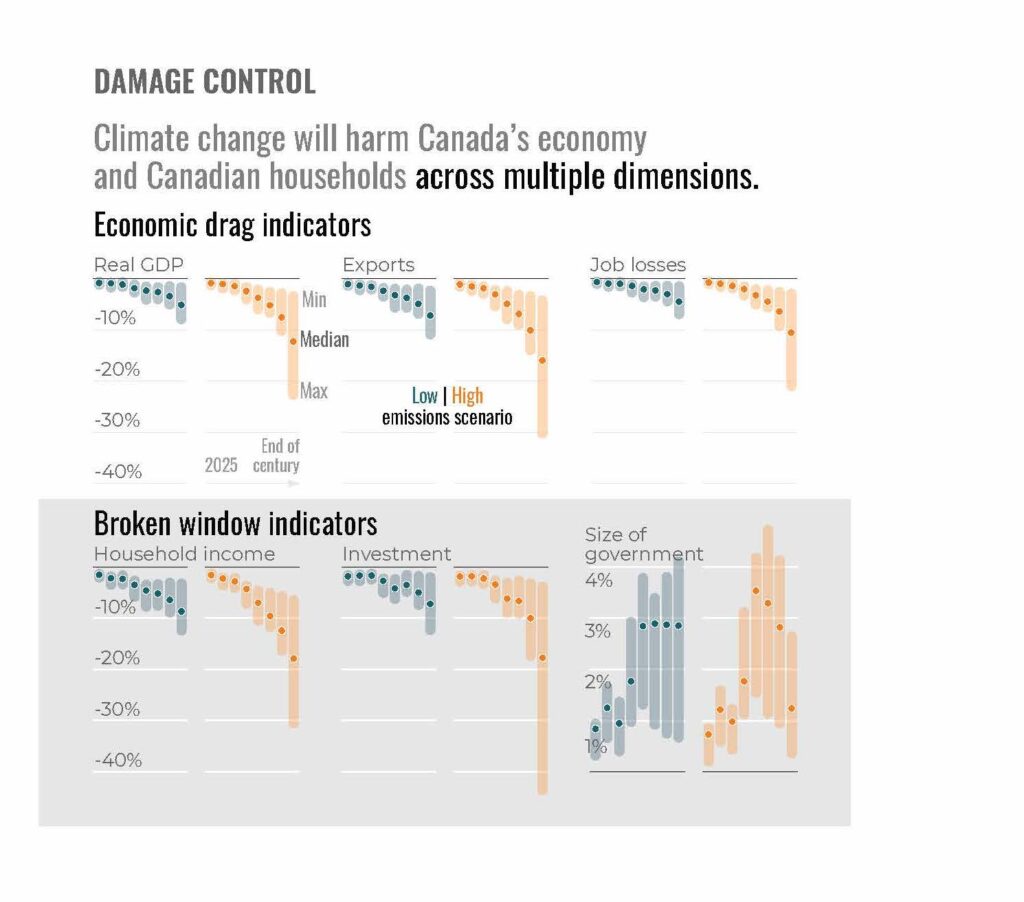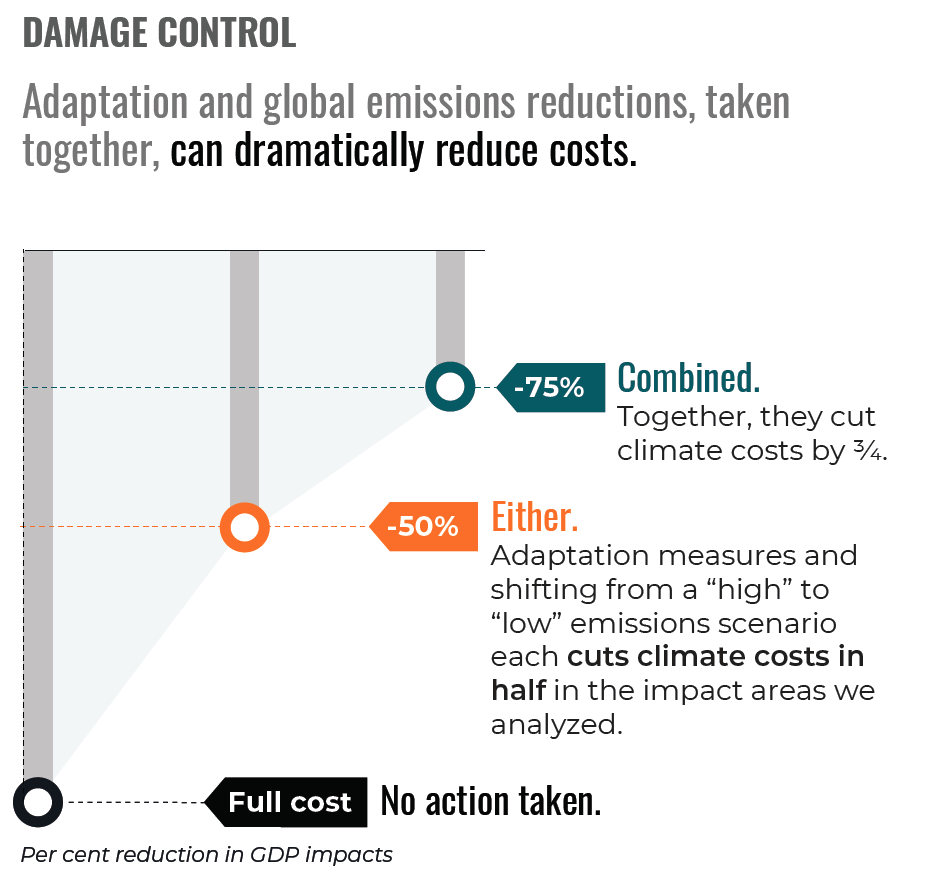OTTAWA, November 24, 2022 – Canada’s first National Adaptation Strategy and federal Adaptation Action Plan, released today, represent a major step toward a more coordinated and effective nationwide response to the devastating effects of climate change.
For a National Adaptation Strategy to save lives and costs, it needs to both set the right direction and be implemented effectively. In the report Closing Canada’s Adaptation Gap: Key elements of a National Adaptation Strategy, experts at the Canadian Climate Institute identify four key elements that would make the Strategy robust and effective. It should:
- Set national adaptation goals and priorities based on risk;
- Identify immediate and actionable short-term policy priorities;
- Define clear governance processes to improve effectiveness and coordination; and
- Create a robust framework for measuring progress and enhancing accountability.
The Strategy and Action Plan released today address or partially address each of these elements. The Strategy identifies long-term goals and objectives for climate change adaptation in Canada across five key areas, and the Action Plan lists important new actions and investments the federal government will make to boost progress in those areas, as well as existing investments that will continue. The Strategy also commits the federal government to coordinating implementation with other orders of government, and proposes specific outcomes against which progress will be measured.
There are also several opportunities for clarification and improvement. Additional detail is needed regarding how the overall goals and priorities of the Strategy address Canada’s biggest climate risks. The processes and responsibilities for coordinating implementation, monitoring progress, and regularly updating the strategy and action plans are currently unclear. And there are still more levers the federal government can use to move climate adaptation forward beyond those outlined in the Action Plan.
The Canadian Climate Institute will publish a detailed analysis of the National Adaptation Strategy in the weeks ahead. We will assess how well the strategy prepares Canada for a changing climate and make recommendations for improving the strategy and its implementation as it is finalized.
Quotes
“From Hurricane Fiona in the East to atmospheric rivers, heat domes, and fires in the West, climate change is already here. A credible and coordinated National Adaptation Strategy will help governments across Canada prioritize measures that protect Canadians from its worst impacts. This Strategy is a major step towards a safer and more resilient Canada—now it’s time to iron out the wrinkles and get to work. Lives and livelihoods are at stake.”
—Ryan Ness, Adaptation Research Director, Canadian Climate Institute
“Climate change is already making life more expensive and more dangerous. Reducing Canadians’ vulnerability to worsening climate impacts is essential to protect our health, safety, and prosperity. Every dollar invested in adaptation can save $13-$15 down the road—we can’t afford to delay making our communities safer and more resilient.”
—Sarah Miller, Adaptation Research Associate, Canadian Climate Institute
“Climate change damage is costing Canada billions of dollars a year. This new strategy gives us a fighting chance to staunch the bleeding. While there is still more to do to ensure this strategy drives meaningful progress, its implementation will help Canada prepare for the threats ahead.”
—Rick Smith, President, Canadian Climate Institute
Key facts
Action on adaptation is long overdue: damages resulting from climate change are already a significant drag on economic growth and a major financial burden on households in Canada, according to the Institute’s recent report Damage Control: Reducing the costs of Climate Impacts in Canada. Our research finds:
- Climate change is already pushing up the cost of living in Canada. By 2025, the average Canadian household could be worse off by $700 a year due to climate change-related factors alone.
- Alberta, the province most exposed to weather-related disasters, could experience median GDP losses at mid-century of $2,890 per capita in a low-emissions scenario or $3,920 per capita in a high-emissions scenario.
- Without investing adequately in adaptation, all households will lose income due to climate impacts, and low-income households will suffer the most—losing between 12 per cent of their income in a low-emissions scenario and 19 per cent in a high-emissions scenario by the end of the century.
- By 2025, Canada will see $25 billion in losses from the warming experienced since 2015, relative to a stable-climate scenario.
- By 2055, those damages could rise to $100 billion and wipe out half a million jobs.
- All of these damages represent only the “tip of the iceberg” when it comes to the climate damages Canada’s economy and society are likely to face. There remain many below-the-waterline risks that can’t yet be accurately modelled.
- Proactive adaptation measures can cut climate costs in half, and when combined with global emissions reductions, can deliver cost savings of three-quarters.
- Adaptation provides a significant return on investment, producing economic benefits of $13-$15 for every $1 spent through avoided direct and indirect costs.
Contact
For further resources or to arrange an interview with one of our experts, please contact:
Janina Stajic
jstajic@climateinstitute.ca
(226) 212-9883
Background
Communities across Canada have been hit hard in recent years by the devastating impacts of climate warming:
- Hurricane Fiona was the most costly extreme weather event ever recorded in Atlantic Canada, according to the Insurance Bureau of Canada, resulting in insurance payouts of $660 million (excluding additional damages not covered by insurance).
- Last year, record torrential rains submerged Vancouver, disrupting the $550 million worth of cargo that moves through the massive port daily, for months on end.
- Canadian homeowners have spent 42 per cent more on their home insurance premiums in the past decade as a direct result of climate change-related damage to properties. Homeowners in Alberta, which is particularly vulnerable to wildfires, experienced a 140 per cent increase.
- Climate change is also partly responsible for the rising price of groceries—last year, extreme weather raised global food prices by 28 per cent.
- Three of the six largest claims ever for federal government disaster assistance came from British Columbia in 2021—$3.5 billion from the November floods, $960 million from spring flooding, and $420 million from wildfires.


